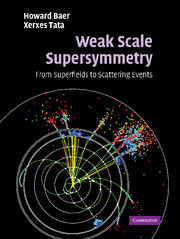Description
Weak Scale Supersymmetry
From Superfields to Scattering Events
Authors: Baer Howard, Tata Xerxes
A comprehensive, practical and accessible 2006 introduction to supersymmetry for particle physicists and graduate students.
Language: English
Subject for Weak Scale Supersymmetry:
Approximative price 60.02 €
In Print (Delivery period: 14 days).
Add to cart
Weak scale supersymmetry: from superfields to scattering events
Publication date: 03-2012
556 p. · 18.9x24.6 cm · Paperback
Publication date: 03-2012
556 p. · 18.9x24.6 cm · Paperback
Approximative price 101.82 €
Subject to availability at the publisher.
Add to cart
Weak scale supersymmetry : From superfields to scattering events
Publication date: 05-2006
556 p. · 17.8x25.3 cm · Hardback
Publication date: 05-2006
556 p. · 17.8x25.3 cm · Hardback
Description
/li>Contents
/li>Biography
/li>
Supersymmetric models of particle physics predict new superpartner matter states for each particle in the Standard Model. These superpartners will have wide ranging implications, from cosmology to observations at high energy accelerators, such as CERN's LHC. In this 2006 text, the authors develop the basic concepts of supersymmetry and show how it can be incorporated into a theoretical framework for describing unified theories of elementary particles. They develop the technical tools of supersymmetry using four-component spinor notation familiar to high energy experimentalists and phenomenologists. The text takes the reader from an abstract formalism to a straightforward recipe for writing supersymmetric gauge theories of particle physics, and ultimately to the calculations necessary for practical applications at colliders and in cosmology. This is a comprehensive, practical and accessible introduction to supersymmetry for experimental and phenomenological particle physicists and graduate students. Exercises and worked examples that clarify the material are interspersed throughout.
Preface; 1. The Standard Model; 2. What lies beyond the Standard Model; 3. The Wess-Zumino model; 4. The supersymmetry algebra; 5. Superfield formalism; 6. Supersymmetric gauge theories; 7. Supersymmetry breaking; 8. The Minimal Supersymmetric Standard Model; 9. Implications of the MSSM; 10. Local supersymmetry; 11. Realistic supersymmetric models; 12. Sparticle production at colliders; 13. Sparticle decays; 14. Supersymmetric event generation; 15. The search for supersymmetry at colliders; 16. R parity violation; 17. Epilogue; Appendices.
Howard Baer is Homer L. Dodge Professor of High Energy Physics at the University of Oklahoma. He specializes in theoretical particle physics and cosmology, working on collider physics, supersymmetry, LHC and dark matter. He has published over 200 articles in refereed journals.
© 2024 LAVOISIER S.A.S.
These books may interest you

The Standard Model and Beyond 105.47 €



